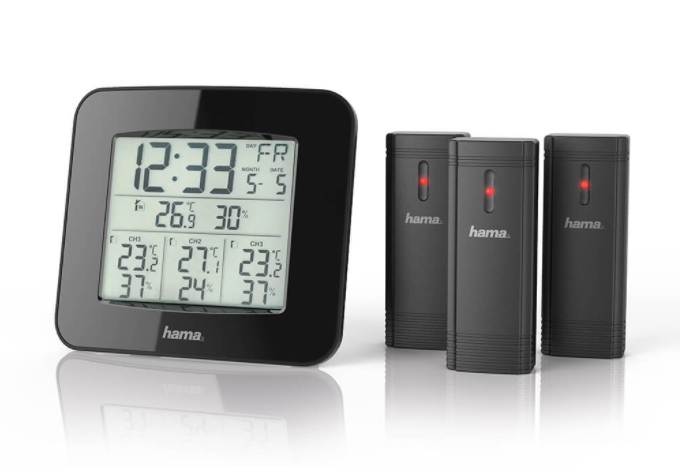hama 186301 Weather Station EWS Intro
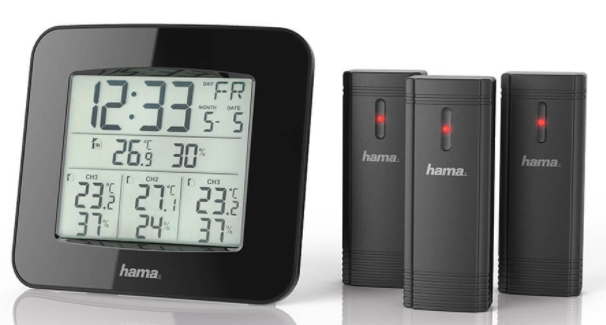
Overview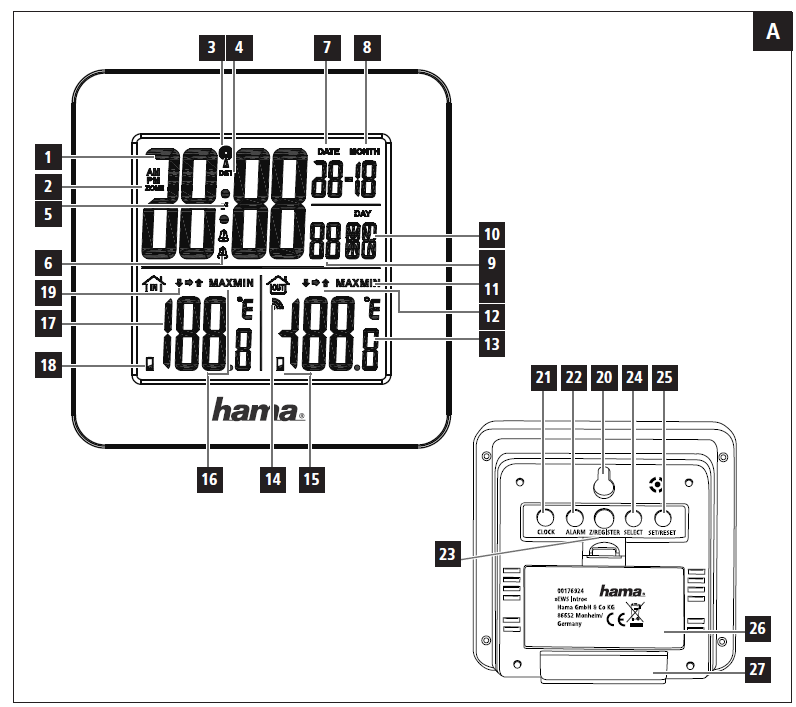
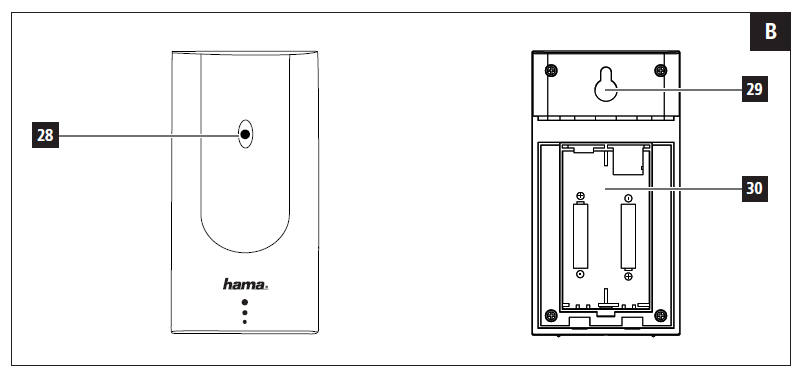
Operating instruction
Controls and Displays
A Base station
- Time
- Time zone display
- DCF radio symbol
- Display summer time
- Snooze symbol
- Alarm 1, Alarm 2
- Day
- Month
- Seconds
- Weekday
- Maximum/minimum outdoor temperature value
- Display of outdoor temperature trend
- Outdoor temperature
- Sensor radio symbol
- Battery capacity of sensor
- Maximum/minimum indoor temperature value
- Indoor temperature
- Battery capacity of weather station
- Display of indoor temperature trend
- Recess for wall mounting
- CLOCK button = settings/confirms the setting
- ALARM button = display/set alarm mode
- Z/Register button = manual search for radio signal/interrupts the alarm/Register
- SELECT buttonselects or stops the alarm/retrieves the maximum/minimum values stored/sets the temperature unit
- SET/RESET button = increases or lowers the setting/reset
- Battery compartment
- BaseB Measuring station
- Status LED
- Recess for wall mounting
- Battery compartment
Explanation of Warning Symbols and Notes
Warning: This symbol is used to indicate safety instructions or to draw your attention to specific hazards and risks.Note: This symbol is used to indicate additional information or important notes.
Package Contents
- EWS Intro weather station (base station for indoors/measuring station for outdoors)
- 4AA batteries
- These operating instructions
Safety Notes
- The product is intended for private, non-commercial use only.
- Do not operate the product outside the power limits given in the specifications.
- Do not use the product in moist environments and avoid splashes.
- Do not use the product in the immediate vicinity of heaters or other heat sources or in direct sunlight.
- Do not use the product in areas where the use of electronic devices is not permitted.
- Do not place the product near interference fields, metal frames, computers, TVs, etc. Electronic devices and window frames can negatively affect the product’s functionality.
- Do not drop the product and do not expose it to any major shocks.
- Do not open the device or continue to operate it if it becomes damaged.
- Do not attempt to service or repair the product yourself. Leave any and all service work to qualified experts.
- Keep the packaging material out of the reach of children due to the risk of suffocation.
- Dispose of packaging material immediately according to locally applicable regulations.
- Do not modify the product in any way. Doing so voids the warranty.
- Use the product for its intended purpose only.
- Keep this product, as all electrical products, out of the reach of children!
- Use the item only in moderate climatic conditions.
Warning – Batteries
- When inserting batteries, note the correct polarity (+ and – markings) and insert the batteries accordingly. Failure to do so could result in the batteries leaking or exploding.
- Only use batteries (or rechargeable batteries) that match the specified type.
- Before you insert the batteries, clean the battery contacts and the polar contacts.
- Do not allow children to change batteries without supervision.
- Do not mix old and new batteries or batteries of a different type or make.
- Remove the batteries from products that are not being used for an extended period (unless these are being kept ready for an emergency).
- Do not short-circuit batteries.
- Do not charge batteries.
- Do not throw batteries in a fire.
- Keep batteries out of the reach of children.
- Never open, damage or swallow batteries or allow them to enter the environment. They can contain toxic, environmentally harmful heavy metals.
- Immediately remove and dispose of dead batteries from the product.
- Avoid storing, charging or using the device in extreme temperatures and extremely low atmospheric pressure (for example, at high altitudes).
Getting Started
Insert batteries
Note: Before use, ensure you insert the batteries in the measuring station first and then in the base station.
Measuring station
- Open the battery compartment (30) and remove the contact breaker.
- Then close the battery compartment cover.
- The status LED lights up.
Base station
- Open the battery compartment (26) and remove the contact breaker.
- Then close the battery compartment cover.
Replacing the batteries
Note – Replacing the batteries
- Note that the stations have to be resynchronised each time after you change the batteries in the measuring or base station.
- To do this, remove the batteries from the other station and then reinsert them, or change them as required.
Measuring station
- If the symbol (next to the outdoor temperature (13)) is displayed, replace the two AA batteries of the measuring station with two new ones.
- Open the battery compartment (30), remove and properly dispose of the dead batteries and insert
- two new AA batteries with the correct polarity. Then close the battery compartment cover.
Base station
- If the symbol (next to the indoor temperature (17)) is displayed, replace the two AA batteries in the base device with new ones.
- Open the battery compartment (26), remove and properly dispose of the dead batteries and insert two new AA batteries with the correct polarity. Then close the battery compartment cover.
Installation
Note – Installation
- We recommend initially placing the base and measuring stations in the intended locations without installing them and making all the settings described in
Operation – to do.Only install the stations once the appropriate settings have been made and a stable wireless connection is established.
Note: The wireless transmission range between the measuring station and base station is up to 30 m in open spaces.
- Before installation, ensure that wireless transmission will not be disrupted by interference or obstacles like buildings, trees, vehicles, high-voltage lines, etc. To avoid transmission interference, do not operate adjacent wireless devices on the same frequency (433 MHz).
- Before the final installation, ensure that there is sufficient reception between the intended installation locations.
- When installing the measuring station, ensure that it is protected from direct sunlight and rain.
- The international standard height for measuring air temperature is 1.25 m (4 ft) above ground.
Warning
- Buy special or suitable installation material from a specialised dealer for wall-mounting.
- Ensure that no faulty or damaged parts are installed.
- Never apply force during installation. This could damage the product.
- Before installation, ensure that the chosen wall is suitable for the weight to be mounted, and make sure that there are no electrical wires, water, gas or other lines at the installation site on the wall.
- Do not mount the product above locations where persons might linger.
Base station
- Use the base (27) to position the base station on a level surface.
- Alternatively, you can install the base station on a wall using the opening (20) on the back.
Measuring station
- You can also position the measuring station on a level outdoor surface.
- We recommend installing the measuring station securely on an outdoor wall using the recess (29).
- Install an anchor, screw, nail, etc. in the wall of your choice.
- Hang up the base/measuring station using the opening (29) intended for this purpose.
Operation
Connection to the measuring stationWhen the batteries have been inserted, the base station automatically searches for a connection to the measuring station and to the radio signal.
Note
- The first search for the measuring station can take up to 3 minutes; the search for the radio signal can take up to 7 minutes.
- If the base station receives no signal from the measuring station, it automatically begins to search for the radio signal after 3 minutes.
- The respective symbols will flash during the connection attempts: connection to the measuring station, connection to the DCF signal
- Do not press any buttons during setup. Otherwise, values may not be transmitted correctly and there is a risk of value errors and inaccuracies.
- Do not change the location of the base station during the search processes.
- The process is completed when the indoor (17) and outdoor (13) measurement data is displayed.
Basic and manual settings
Automatic setting using the DCF signal
When the base station has been switched on for the first time and successful transmission has been established between the base station and the measuring station, the clock will automatically search for the DCF signal. During the search, the radio symbol flashes.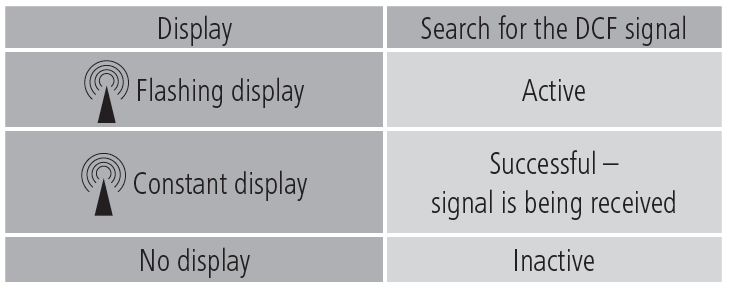
If the station still does not receive a signal, press and hold the Z/Register button (23) for approximately 3 seconds to start the manual search for the DCF signal. The DCF radio symbol (3) begins to flash.
Note – Time settings
- The search process can take up to 10 minutes. If the search fails, it ends and is repeated at the next clock hour. The DCF radio symbol (3) goes out.
- In the meantime, however, you can set the time and the date manually.
- The clock automatically continues to search for the DCF signal on a daily basis (between 2 am and 4 am and between 5 am and 6 am). If the signal is received successfully, the manually set time and date are overwritten.
Note – Summer timeThe clock automatically switches to summer time. appears on the display as long as summer time is activated.
Manual settings
- Press and hold the CLOCK button (21) for approximately 3 seconds to make the following settings one after the other:
- 12 or 24-hour format
- Weekday language (GE = German, FR = French, ES = Spanish, IT = Italian, EN = English)
- Time zone (from -12 to +12 hours CET)
- Hour
- Minute
- Second
- Year
- Month
- DayPress the SET/RESET button (25) to select your setting. Press the CLOCK button (21) to confirm your entries.
Note – Time zone
- The DCF signal can be received over long distances, but always transmits the current Central European Time in Germany. Make sure you account for the time difference in countries in other time zones.
- If you are in Moscow, the time is 3 hours later than in Germany. This means that you should set +3 for the time zone. The clock then sets the time automatically to 3 hours ahead after receiving the DCF signal or according to the manually set time.
Alarm
- Press and hold the ALARM button (22) for approximately 3 seconds to set the time of the alarm displayed. The hours display begins to flash.
- Press the SET/RESET button (25) to select the hour for the alarm time and confirm your selection by pressing the ALARM button (22). The minutes display begins to flash.
- Repeat the process to set the minutes for the alarm time.
- Repeat the entire process to set the second alarm.
- If you do not make an entry for 25 seconds, you automatically exit the setting mode.
- Press the ALARM button (22) once to display the first alarm time. Press the ALARM button (22) once more to display the second alarm time.
- Press the SET/RESET button (25) once to activate the first alarm. Press the SET/RESET button (25) once more to activate the second alarm. Press the SET/RESET button (25) a third time to activate both alarms.
- An activated alarm is indicated by the respective symbol 1 / 2 on the display.
- Press the SET/RESET button (25) repeatedly to deactivate the daily alarm. The alarm symbol 1 / 2 is not displayed.
- If the alarm is triggered, the alarm symbol is displayed and an alarm will sound.
- Press SELECT (24), SET/RESET (25), ALARM (22) or CLOCK (21) to stop the alarm. Otherwise, it will stop automatically after 2 minutes.
Note – Snooze function
- While the alarm is sounding, press the Z/Register button (23) to activate the snooze function. The snooze symbol Zz and alarm symbol 1 / 2 begin to flash on the display. The alarm signal will stop for approximately 5 minutes, after which it will sound again.
- Press the SELECT button (24) to stop the snooze function and the alarm.
Temperature (Celsius/Fahrenheit)
- Press and hold the SELECT button (24).
- Press the SET/RESET button (25) to choose between °C and °F for the temperature display.
- Confirm your selection by pressing the SELECT button (24).
- The weather station indicates a trend as to how the values for the outdoor temperature and room temperature are likely to develop over the next few hours.

Maximum and minimum temperature values
- The base station automatically stores the maximum and minimum outdoor/indoor temperature values.
- Press the SELECT button (24) to display the maximum values. Press the SELECT button (24) again to display the minimum values.
- Press the button a third time to go to the standard view.
Care and Maintenance
Only clean this product with a slightly damp, lint-free cloth and do not use aggressive cleaning agents. Make sure that water does not get into the product.
Warranty Disclaimer
Hama GmbH & Co KG assumes no liability and provides no warranty for damage resulting from improper installation/mounting, improper use of the product or from failure to observe the operating instructions and/or safety notes.
Technical Data
| Base station | Measuring station | |
|
Power supply |
3.0 V 2x AA batteries |
3.0 V 2x AA batteries
We recommend using AA lithium batteries for the outdoor sensors when outdoor temperatures are below 0°C/32°F. |
|
Measuring range: Temperature |
0°C – 50°C 32°F – 122°F |
-20°C – +60°C – 4°F – +140°F |
| Measurement increments |
0.1°C/32.2°F |
0.1°C/32.2°F |
| DCF radio- controlled clock |
Yes |
No |
|
Alarm function |
Yes |
No |
| Max. transmitting power |
20.5 µW |
|
| Max. number of measuring stations |
1 |
|
| Frequency | 433 MHz | |
| Range | ≤ 30 m |
Declaration of Conformity
Hereby, Hama GmbH & Co KG declares that the radio equipment type [00186301, 00176924] is in compliance with Directive 2014/53/EU. The full text of the EU declaration of conformity is available at the following internet address: www.hama.com -> 00186301, 00176924 -> Downloads.
Maximum radio-frequency power transmitted 0,021 mW
Recycling Information
Note on environmental protection:
After the implementation of the European Directive 2012/19/EU and 2006/66/EU in the national legal system, the following applies: Electric and electronic devices as well as batteries must not be disposed of with household waste. Consumers are obliged by law to return electrical and electronic devices as well as batteries at the end of their service lives to the public collecting points set up for this purpose or point of sale. Details to this are defined by the national law of the respective country.
This symbol on the product, the instruction manual or the package indicates that a product is subject to these regulations. By recycling, reusing the materials or other forms of utilising old devices/Batteries, you are making an important contribution to protecting our environment.
References
[xyz-ips snippet=”download-snippet”]

